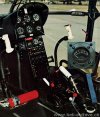LOL. No, REALLY. Army IPs are dipshits. I watched Army IPs time and again teach aero topics, especially compressibility, VRS and retreating blade stall, wrong. You're right, I had the benefit of being in both services with experience as an instructor in both services, something few Army IPs had. Most Army IPs are not college graduates. For me, an NROTC scholarship student, I had to take calculus and physics. I was a math major so I understand the math principles pretty well. If you read books or white papers on the design the Black Hawk, or read books by Proudy for fun, the subtle aspects of helicopter design are fascinating. But for the lowest common denominator of Army IPs, "Lifties" explanations of aerodynamics are difficult to understand, much less teach. What makes them dipshits is that when provided correct explanations of aero topics, they refused to alter their explanation to their students.I didn't say that. I said there is an unwillingness from many (but not all) of the IPs I'm having to deal with that won't think beyond what their gouge is saying when teaching the training manual.
Also, you were not a straight-stick Army IP. Don't pretend you were....you had the benefit of getting exposure to both services. You've even made comments about how your Navy experience increased/improved your bag of tricks compared to a someone just exposed to the Army training (I still chuckle at your PTP story).
I was wondering if you were still around on the site and if you'd chime in (and welcome it). My intent isn't to degrade your experience, and in fact, it's clear you're understanding the very concept I initially brought up and are willing to discuss it based on actual performance data.
But some large percentage of Check Airmen that I have to fly with clearly don't, and will even refuse to debrief the discussion after the flight. Again, it's not all of them, but it's notable.
Early on at HAATS I flew a flight into a confined area about the size of a football field at 10,000' ish. I was proud I had hit my numbers and flew a great approach and landing. Then I was VERY embarrassed that I had gotten so involved in the landing I hadn't thought about the power required to get back out. I had an abort and a takeoff route picked out, but I had not calculated the OGE power required to get out...only IGE. Getting in with IGE was doable. Getting out? Not as much. This is where the learning occurred. We did several takeoff attempts using IGE power trying to get over the trees without exceeding our artificial power limit and finally made it with only a momentary exceedance of a couple percent Q.
When flying at those altitudes, the aircraft handles differently, so you get better experience than just artificially limiting your power available. I remember one takeoff from a plateau that kicked my ass, and eventually the IP tried it and failed as well, even though he had done it successfully in the past. It involved transitioning to forward flight from a 5' hover down a slight downslope. One third of the way was a 3' drop down before continuing with the fairly smooth downslope. Every time coming off the 3' drop I/we would either mush down and touch the tailwheel or exceed our power available. After about 4-5 attempts we set down and discussed things. We noticed a rock structure just to the left of our path that blocked the 5-10 kt breeze coming from about 30 degrees left of takeoff course. The wind shadow (I'm a sailboat racer as well) from the rock structure occurred as we crossed the 3' drop off. Operating at sea level this probably would not have happened, but the thin air made the aircraft less responsive and allowed that small wind shadow to more negatively affect our aircraft and mush more than it would have at sea level.
I think one reason Vx is not taught a lot is because it is such a gray area in actual aircraft performance. Even IF you can hover OGE, if you are near the limits of your OGE power with respect to ceiling, not ground effect, it is possible you could reach your ability to climb vertically before clearing the obstacle. Slight variations in wind speed, wind direction, turbulence, ground contour, aircraft configuration, etc...could make a difference in Vx. It could be 0 to 15-20 kts. How well do pitot tubes work at that speed?
My technique to fly Vx is to accelerate until you feel the nose try to pitch up. Once you feel the nose pitch up going through translational lift, set your pitch to maintain that AIRSPEED and fly out. Maintaining an airspeed with nothing registering on your pitot tubes takes feel. The 60M with a significant aft CG requires a positive stick forward nose down effort. The 60A/L was fairly neutral. I don't remember what the 60B with a PBA did going through translational lift. AFCS software and stabilator programming could also make differences in Vx, all within an S70 model aircraft. Given that the Navy, Air Force and Coast Guard all followed what the Army did in the beginning, there is no surprise that a) Vx would be different between services, b) Vx would be ambiguous and c) even IPs would not know a lot about it.

